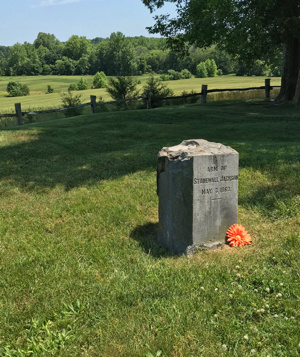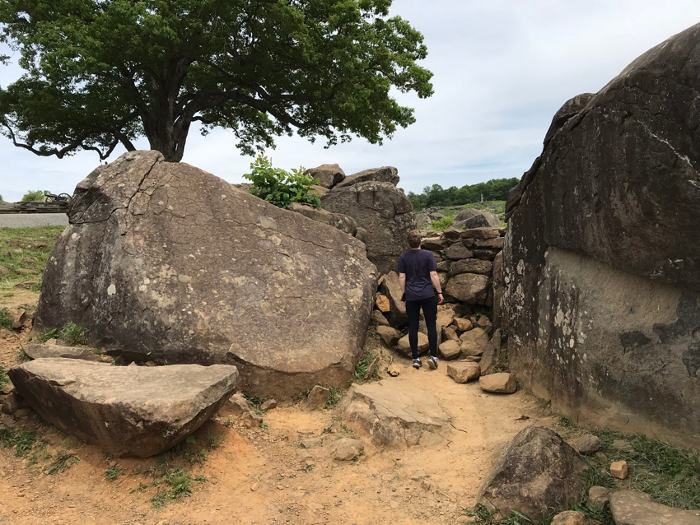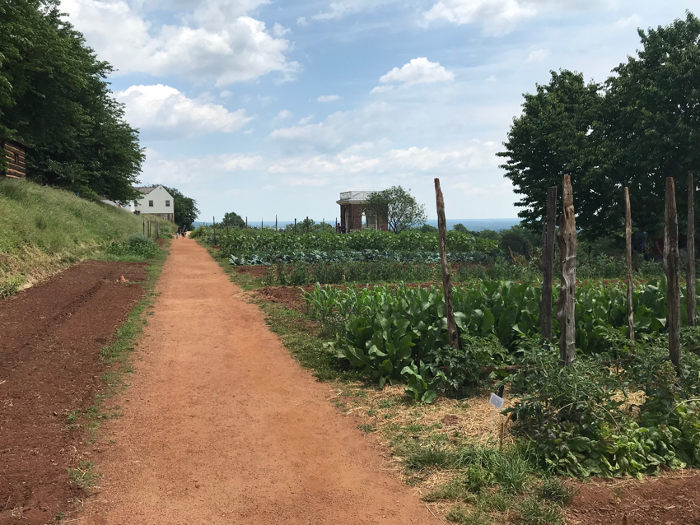4 Things I Learned During My #civilwarsupertour
What better way to spend part of May tramping around places like Gettysburg, Antietam, Chancellorsville, Harpers Ferry, and Corydon, Indiana?

Maybe it’s there.
Maybe it’s not.
But we had to go either way, just to say we did. Because it’s not very often that you get the chance to view the burial site of someone’s arm.
So we followed a dirt road off the main highway down to Ellwood Manor near the Chancellorsville battlefield. We had a great tour of the house, discussed why Union general Sheridan hated his fellow general Sedgwick, and examined the cannon balls embedded in a preserved tree trunk.
And then . . . the arm cemetery.
On May 2, 1863, during an evening scouting ride, Confederate general Stonewall Jackson was shot multiple times by his own troops. His left arm was amputated and he died days later from pneumonia. But military chaplain Tucker Lacy didn’t think that the arm of such a Confederate rock star should end up in a pile of limbs of lesser men. So he wrapped the arm in a blanket and took it to the family cemetery at Ellwood. The chaplain gave the limb a standard Christian burial and placed a marker above the site.
The arm is still there. At least the marker is. Urban legends suggest multiple attempts at reburials including one by a Marine Corps general in the 1920s. After conversations and research, the National Park Service staff there aren’t so sure.
Tools and ideas to transform education. Sign up below.
But it was an interesting side trip as a part of the larger Wiebe family Civil War Battlefield Extravaganza. Inspired by Tony Horowitz’s book Confederates in the Attic, three of us spent ten days last month exploring multiple sites, battlefields, and that one cemetery with the arm.
It’s was awesome.
As a self-described history nerd, what better way to spend part of May tramping around places like Gettysburg, Antietam, Chancellorsville, Harpers Ferry, and Corydon, Indiana? I’ve got pictures. Lots and lots of pictures.
But how about four things I learned instead?
It’s all about the stories – not just the dates and places

Jackson’s arm is a story. The police chief who was present the night President Lincoln was assassinated. Alexander Gardner moving bodies around at Gettysburg to create a more marketable photograph. The doll that belonged to the daughter of William McLean, owner of the house where Lee and Grant met in 1865, “confiscated” as a souvenir of the surrender ceremony. All stories that can engage kids and help them see connections to the present.
Too often, we saturate our students with lists of people, places, and events – delivered with good intentions but done in a way that sucks the life out of all of it, chasing kids away from some of the the most important stuff they need to know in order to be effective citizens.
Paraphrasing James Loewen:
Kids don’t hate history. They hate the way we teach it.
As educators, we need to find the stories that can hook kids and help them explore the bigger issues that go way beyond just memorizing people, dates, and places.
Some sites and museums tell better stories than other sites and museums
The National Park Service museum at Gettysburg? Amazing. Monticello? Yes. The Carriage House Bed and Breakfast in Charles Town, Virginia, just down the street from where John Brown was hanged, where a flag was crafted that ended up being carried bu Confederate troops at the first battle at Bull Run, and where US Grant planned attacks in Confederate troops in the Shenandoah Valley using information provided an African American spy? Crazy interesting. The 75 year old volunteer docent at the Ellwood house? Absolutely.
Others who will not be mentioned? Not so much. Why? Crappy story telling skills. Seriously, people. Update your exhibits, it’s 2019.
It’s about the great resources
You don’t have to travel to all of these places to get their super sweet teaching tools. Go online for tons of resources:
- O Say Can You See? Early Washington DC
- Mount Vernon Education
- Monticello for Educators
- The Battlefield Trust
- National Park Service Teaching with Historic Places
- Gettysburg for Teachers
- Antietam for Teachers
- Chancellorsville / Fredericksburg / Spotsylvania for Teachers
- African American Civil War Museum
- Ford’s Theater for Teachers
It’s always been about slavery

History isn’t simple. Or easy. It’s messy and complex and interwoven and interesting and fascinating and it’s who we are. And we need to be willing to take kids down that path.
Our trip started as a semi re-creation of Horowitz’s Confederates book. But others in the family hadn’t been to Mount Vernon or Monticello. So we threw those into the mix – with a specific intention of making connections between Washington, Jefferson, and the Civil War.
It wasn’t hard. It’s always been about slavery.
Thomas Jefferson spent much of his life wrestling with and proposing various solutions to what he called “this deplorable entanglement.” But slavery was not abolished, and he remained a slaveholder throughout his life, suggesting that any solution to the problem would be up to the next generation.
And after Jefferson died in 1826, his estate was on the hook for the equivalent of $2.5 million. Part of the solution was to offer for sale 107 of his enslaved workers – breaking up families and selling them across the country.
A docent shared how Monticello is “leaning into the topic” of slavery and the paradox of Jefferson’s words in the Declaration of Independence and his owning, buying, and selling hundreds of people. The docent and a small group of us had an interesting discussion around the legacy of that paradox. The Civil War, obviously. But also:
- Unfair sharecropping practices
- Jim Crow laws
- Growth of the KKK
- White supremacists
- Black Lives Matter
- School to prison pipeline
- 2016 events in Charlottesville, Virginia
- Current political polarization
So Monticello is engaging in intentional conversations around the relationship between Jefferson and his enslaved mistress Sally Hemings. Exhibits highlight the lives of those he enslaved and, using primary sources, describe the complex and difficult relationships between the many different groups that lived at Monticello.
A current project called Getting Word focuses on interviewing descendants of Monticello’s African American community. You’ll find some amazing stories and resources here – perfect for an Inquiry Design Model lesson or a student PBL.
We found numerous connections and threads running from Jefferson and Monticello to the 1860s, the turn of the century, and today. Just a couple:
Joseph Fossett descendant William Monroe Trotter attended Harvard University and with others from Storer College was one of the founders of the Niagara Movement, forerunner of the NAACP. Storer College was founded in Harper’s Ferry after the Civil War as a school for former enslaved persons. Trotter’s grand-niece, Peggy Preacely, noted, “I had to do something in my lifetime to make a difference because Uncle Monroe did.” She became an active participant in the civil rights movement of the 1960s.
Coralie Franklin Cook was the first descendant of a Monticello slave known to have graduated from college. She taught at Storer College and Howard University. In her 1915 essay titled “Votes for Mothers,” she wrote:
Disfranchisement because of sex is curiously like disfranchisement because of color. It cripples the individual, it handicaps progress, it sets a limitation upon mental and spiritual development.
She was a committed suffragist and joined forces with Susan B. Anthony, eventually leaving the movement, feeling it had “turned its back on women of color.”
Mount Vernon does have an extensive series of slavery related exhibits within its museum and is striving to find ways of effectively telling the stories of both Washington and those enslaved there. Including stories around those enslaved who were freed after he died and those owned by his wife who were not.
During our time in parts of four states, we found the story and legacy of slavery interwoven into every place we visited. From before the United States was even a country, to its founding fathers, John Brown’s attacks in Kansas and Harper’s Ferry, to places like Devil’s Den and Bloody Lane, the McLean House in Appomattox, in the President’s Box in Ford’s Theater, 1920s memorial statues to the Lost Cause, and to current places like Charlottesville.
So.
My take away after 10 days in the car?
Battlefields, stone monuments, and museum exhibits (and their digital resources and lesson plans if you can’t be there in person) are awesome history gateway drugs. When we do it well, they give us a great way to engage kids in content, help us tell better stories, and can connect the past with present.
I paraphrased James Loewen earlier. And he’s right.
- Kids don’t hate history. Not if it’s done in an engaging style with images and great questions and small groups and problems to solve.
- Kids don’t hate learning more about historical characters. Not when we tell them stories of actual people and how they survived the attack on Little Round Top or a teenager’s experience during the Montgomery Bus Boycott or a trip from Haiti to the Florida Keys on a homemade raft or a parachute drop behind Omaha Beach from a World War II vet or . . . well, just about any event well told.
- Kids don’t hate maps. A good map can tell incredible stories. Used correctly, they can draw a viewer in with what Robert Louis Stevenson once called the power of “infinite, eloquent suggestion.”
- Kids don’t hate reading and writing. My older son and his friends are huge fans of The Game of Thrones. They’ve got the books, they write fan fiction, they read and comment on blogs. They read immense amounts of non-fiction and informational text. The lesson is that we need to give kids some choice in what we ask them to read and write about.
They don’t hate history. Not when it’s done well – with relevancy and choice and small groups and engaging problems and interesting documents and outside experts and technology and authentic products.
During the trip, the daughter created a new verb. We saw multiple school groups, mostly middle school kids, at many of these places. It seems like most would simply be told to tour the exhibits or battlefield and then were left on their own. The result? Within fifteen minutes, the majority were in a corner checking their phones or sleeping.
“Middle school” became our code word phrase for skipping a site or hurrying through an exhibit without really paying attention. As in:
Dad . . . looks like you pulled a huge middle school on that last section of Civil War cannon ball examples.
My takeaway? As history teachers, we aren’t allowed to pull a middle school. Focus on all of our history, even the uncomfortable stuff, and make sure that kids can’t find an excuse to hate what we teach because of the way we teach it.
cross posted at glennwiebe.org
Glenn Wiebe is an education and technology consultant with 15 years' experience teaching history and social studies. He is a curriculum consultant forESSDACK, an educational service center in Hutchinson, Kansas, blogs frequently at History Tech and maintains Social Studies Central, a repository of resources targeted at K-12 educators. Visit glennwiebe.org to learn more about his speaking and presentation on education technology, innovative instruction and social studies.
